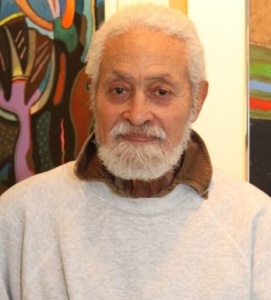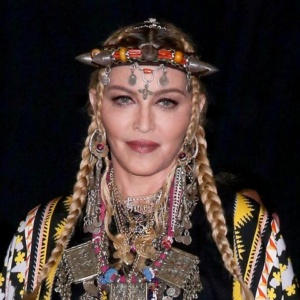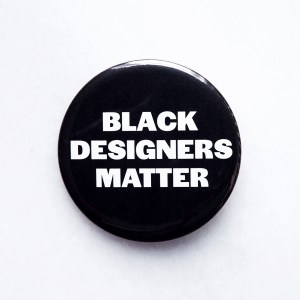Unicorns Are Real: Black Graphic Designers after George Floyd
The artwork above is an illustration for Amtrak Express magazine, 1983, by Reynold Ruffins,
Change your perception of things and you will change your reality.
Milton Glaser, the legendary New York City graphic designer and creator of the iconic ‘I ♥ NY’ logo passed away on June 26, 2020. He started Push Pin Studios with four former Cooper Union classmates in 1954. The New York Times honored him in an article saying he changed the vocabulary of American visual culture in the 1960s and ’70s with his brightly colored, extroverted posters, magazines, book covers and record sleeves. LinkedIn was showered with praises about Glaser after his death.
 Now, how many of you know who Reynolds Ruffins is? He passed away July 11, 2021. You. can see some of his work here. Ruffins was a graphic desginer, illustrator, painter and a partner along with Seymour Chawst, Edward Sorel and Milton Glaser at Pushpin Studios. When I searched Google for Milton Glaser, 2,670,000 results came up. When I searched Google for Reynold Ruffins, 573,000 results came up. I understand that Google results only reflect searches not importance but in this digital age, it is becoming harder to separate the two. Just so you know, Ruffins is African American…and a unicorn.
Now, how many of you know who Reynolds Ruffins is? He passed away July 11, 2021. You. can see some of his work here. Ruffins was a graphic desginer, illustrator, painter and a partner along with Seymour Chawst, Edward Sorel and Milton Glaser at Pushpin Studios. When I searched Google for Milton Glaser, 2,670,000 results came up. When I searched Google for Reynold Ruffins, 573,000 results came up. I understand that Google results only reflect searches not importance but in this digital age, it is becoming harder to separate the two. Just so you know, Ruffins is African American…and a unicorn.
The Perception
 The unicorn is a mythical creature with a single large pointed horn in the middle of its head. They have been found in descriptions since antiquity in Europe and South Asia. Interestingly, the King James version of the Bible translates the Hebrew word re’em as unicorn in Job 39:9 while the NIV Bible translates it as wild ox. It is usually depicted as a wild white horse that symbolizes female virginity and purity.
The unicorn is a mythical creature with a single large pointed horn in the middle of its head. They have been found in descriptions since antiquity in Europe and South Asia. Interestingly, the King James version of the Bible translates the Hebrew word re’em as unicorn in Job 39:9 while the NIV Bible translates it as wild ox. It is usually depicted as a wild white horse that symbolizes female virginity and purity.
Modern people associate unicorns with fantasy, obscurity and rarity. I am using it to symbolize the Black graphic designer because many in the graphic design industry and its allies have often CHOSEN not to see us.
I hate the fact that George Floyd had to die in order for mainstream America to learn simple lessons that Black people have been communicating for decades. This has been an ongoing issue since Black people were enslaved in the United States and is evidenced by the high profile deaths of Martin Luther King, Medgar Evers, Emmitt Till, Nat Turner and countless Black men and women who have been victims of personal and state stationed racial terrorism. Floyd’s death woke White people up but it shocked Black people back to life in the form of protests and rallies. Black businesses are receiving a great deal of support from the Black community. As a result, large companies have jumped onboard initiating DEI (Diversity, Equity and Inclusion) trainings while major cities, all of a sudden, know how to find Black businesses for their contracts.
But make no mistake, before George Floyd’s death, the argument from majority White companies and design agencies was always we cannot find Black designers. Ask any Black graphic designer that has been in the field for 20+ years. Most formally trained Black designers I know always understood this explanation as a straight up lie. Several articles have been written about the idea of ‘black designers missing in action’ in design publications since the 1960s. Although I admit that the number of Black graphic designers are small, when you take into account other disciplines of design, (UX, UI, product design, social media, etc.), education range (DIY, 2-year, 4-year, etc.) and add the term ‘creative’ in heavy use among the Millennial generation, I believe the numbers are much larger. I never did fully embrace the results of the 2019 Design Census created by Google and the AIGA. Here is an excerpt from my Open Letter to the White Graphic Design Community I wrote a year ago:
The usual argument was always, where are the Black designers? Back in 1987, Cheryl D. Miller wrote an article about it in Print Magazine. The Organization of Black Designers (OBD) spoke into the void as well in the 1990s. Revision Path founded by Maurice Cherry has interviewed Black creative professionals since 2013. He also wrote an article on behalf of AIGA’s Diversity and Inclusion Initiative revisiting the ‘MIA Black Designers’ issue. African American Graphic Designers Facebook Group started by Terrence Moline has close to 3,000 members, a website and is growing exponentially. Black designers have talked about this topic ad infinitum. There are also other FB groups catering to Black designers.
Yet, according to the 2019 AIGA Design Census, only 318 Black designers (3%) completed their survey. It was open to the public for five weeks and shared directly with AIGA’s members, attendees of the AIGA Design Conference, and the wider U.S. design community. The media channels used were social media and paid advertising.
With all of the talent connected to the AIGA and its conferences, you mean to tell me that none of them could find out that Black people are heavy social media users? Well, somehow the Russians found out two years ago and targeted African Americans with online fake news!! Maybe the AIGA should contact Putin and ask him for help. This should remind us that AIGA’s sampling and their ad targeting was not broad enough. Don’t ask where the Martians are if you aren’t willing to go to Mars..
The enduring perception is that we do not exist and the stereotype is that when we are found, we lack talent. Lately, the AIGA has been playing catch up giving its prestigious medals to Black living legends Cheryl D. Miller and Archie Boston yet there are numerous other artists/designers that are important to the Black community that have been ignored.
The Reality
 I will not argue that there are more Black graphic designers than white ones. I also won’t deny how the high tuition at A-list design schools, the lack of exposure through public education and discrimination play a role in African Americans not choosing graphic design. But considering the importance of African American visual and cultural expressions over the last 100 years, you have to NOT BE LOOKING to see the impact on America’s cities (and globally) since The Harlem Renaissance and The Great Migration. The evidence can be seen in fashion, visual arts, performing arts, speech, sports, etc. Considering the American graphic design community’s wholesale adoption of Swiss design principles, you would swear that this imported philosophy was birthed in the U.S.
I will not argue that there are more Black graphic designers than white ones. I also won’t deny how the high tuition at A-list design schools, the lack of exposure through public education and discrimination play a role in African Americans not choosing graphic design. But considering the importance of African American visual and cultural expressions over the last 100 years, you have to NOT BE LOOKING to see the impact on America’s cities (and globally) since The Harlem Renaissance and The Great Migration. The evidence can be seen in fashion, visual arts, performing arts, speech, sports, etc. Considering the American graphic design community’s wholesale adoption of Swiss design principles, you would swear that this imported philosophy was birthed in the U.S.
 Cheryl D. Miller has released an updated series of brave articles about Black designers in 2020 pulling no punches. Then, she committed what the graphic design industry may consider a cardinal sin: She raised questions about why African American artists and designers weren’t considered for art/design projects…from African American entertainers. Milton Glaser designed album covers for legendary African American musical pioneers in the 60s and 70s yet other Black designers practicing in New York City were ignored.
Cheryl D. Miller has released an updated series of brave articles about Black designers in 2020 pulling no punches. Then, she committed what the graphic design industry may consider a cardinal sin: She raised questions about why African American artists and designers weren’t considered for art/design projects…from African American entertainers. Milton Glaser designed album covers for legendary African American musical pioneers in the 60s and 70s yet other Black designers practicing in New York City were ignored.
In addition, Black designers are rarely mentioned in art and graphic design history books. Philip Meggs, A History of Graphic Design, mentions Reynold Ruffins but would rather highlight arts movements in Europe and identify those Europeans that emigrated to the U.S. influencing American art and design. Let’s be clear about something: History has shown consistently that White Americans often react negatively to the revolutionary nature of African American movements because they are so overtly political considering the nature of racism and discrimination in this country. But this same cynicism evaporates when examining imported European movements such as Cubism, Futurism, Bauhaus, De Stijl, etc. These movements were also reacting to political changes and shifts in their part of the world as well. Black artists and designers during the Harlem Renaissance and those who contributed to the Black Protest Movements of the 60s and 70s such as Emory Douglas, Barbara Jones-Hogu, Wadsworth Aikens Jarrell contributed to the formation of Black identity.
African American artists and designers have been marginalized while. simultaneously, African American culture has been utilized by White artists and designers to sell products and services to White America. Google the word ‘blackfishing’ and see how far cultural appropriation goes.
Post George Floyd
Back in 2016, I officially registered as a minority business in the City of Philadelphia’s database. The city has an admirable goal of 35% participation from enterprises owned by women, people of color and people with disabilities. (Big shout to my Eastern University grad school classmate, Deputy Commerce Director of the Office of Economic Opportunity, Iola Harper, who is helping make this happen.) Once I signed up, I started responding to RFPs on the Phila.gov website. I also hoped that a large company (probably majority white) might see my business name and consider pulling me into a project. Not one company contacted me until after May 25, 202o…when George Floyd was murdered by a Minneapolis police officer. Frustrated with the lack of opportunities, the complicity of the White graphic design community in Philadelphia and my alma mater, I penned an open letter one month later. I posted it in various graphic design FB groups including my almer mater’s group. I appreciate the two faculty from my alma mater that responded but that was it.
For almost a year, I received regular calls from local design agencies and companies looking for a designer. I am part of a FB group of Black designers and they were experiencing the same thing. Some connections turned into partnerships, others I declined because of unclear motives and a few just gave me Hollywood talk (They would say one thing and do another). But this vindicates what Black designers have been saying all along: It not a lack of talent on our part, it a lack of the will by these majority White companies and agencies. Why is it that, all of sudden, they can find us now but before Floyd’s death, we were invisible? This means they took the initiative whereas in the past, they simply did….nothing or barely did anything.
 Although I am an optimist, I am somewhat skeptical about whether there will be lasting change. Woke washing is a real thing and I do believe this present fixation with DEI (Diversity, Equity and Inclusion) will dissipate. Something new and sexy will probably replace this important issue. I have reason to believe this because in my 50+ years as a Black professional on this earth, I have had to compete against less experienced White designers. I also have seen the reactions to Black political demands before from White America over the years. Although I have White friends who are doing the work of monitoring and responding to racism and racist ideas in their own lives as I walk with them, I wonder if there is too much vested interest in past perceptions for things to change. However, I do see some bright spots in academia as various colleges and universities hire Black design professors, bring in icons like Cheryl D. Miller and hold conferences around Black aesthetics, Black design and Black liberation. I also hope that Black professionals will continue doing exceptional work in design and related fields, keep developing our own philosophies and methodologies (Dori Tunstall, Lesley-Ann Noel and Omari Souza), continue writing and recording our own stories and histories (Revision Path) and creating our own design publications (Umber Magazine). African Americans have had a very diverse aesthetic for a long time. We need to continue marinating in it and sharing it with those who will appreciate it. I am grateful to fellow alum Kristina Lamour Sansone at Lesley University for taking the risk to address DEI in her circle of influence. Although I don’t agree with the methodology of all DEI initiatives, I do see some promise.
Although I am an optimist, I am somewhat skeptical about whether there will be lasting change. Woke washing is a real thing and I do believe this present fixation with DEI (Diversity, Equity and Inclusion) will dissipate. Something new and sexy will probably replace this important issue. I have reason to believe this because in my 50+ years as a Black professional on this earth, I have had to compete against less experienced White designers. I also have seen the reactions to Black political demands before from White America over the years. Although I have White friends who are doing the work of monitoring and responding to racism and racist ideas in their own lives as I walk with them, I wonder if there is too much vested interest in past perceptions for things to change. However, I do see some bright spots in academia as various colleges and universities hire Black design professors, bring in icons like Cheryl D. Miller and hold conferences around Black aesthetics, Black design and Black liberation. I also hope that Black professionals will continue doing exceptional work in design and related fields, keep developing our own philosophies and methodologies (Dori Tunstall, Lesley-Ann Noel and Omari Souza), continue writing and recording our own stories and histories (Revision Path) and creating our own design publications (Umber Magazine). African Americans have had a very diverse aesthetic for a long time. We need to continue marinating in it and sharing it with those who will appreciate it. I am grateful to fellow alum Kristina Lamour Sansone at Lesley University for taking the risk to address DEI in her circle of influence. Although I don’t agree with the methodology of all DEI initiatives, I do see some promise.
So, although majority White companies and agencies may go back to the Land of Make Believe seeing us as unicorns, we Black designers know otherwise. In the meantime, I am trying to wedge the door open for younger Black designers because…they will probably have to address this issue again. I am hoping that they will channel their ancestors and stand for what is just and right….because Black designers are real and aren’t going anywhere. Thank you Reynold Ruffins for blazing trails with your art, graphic design and illustrations. We see you.
